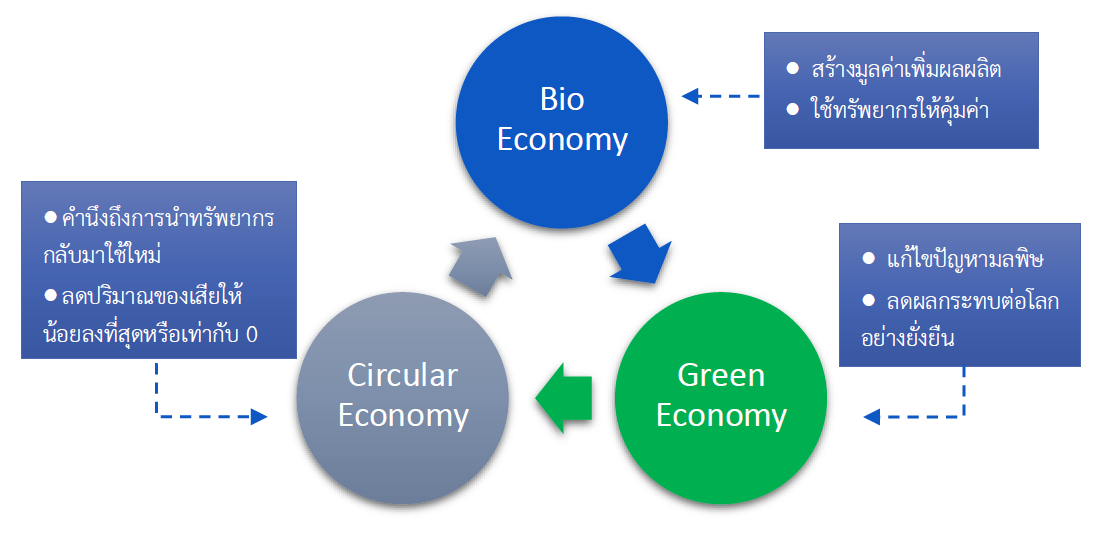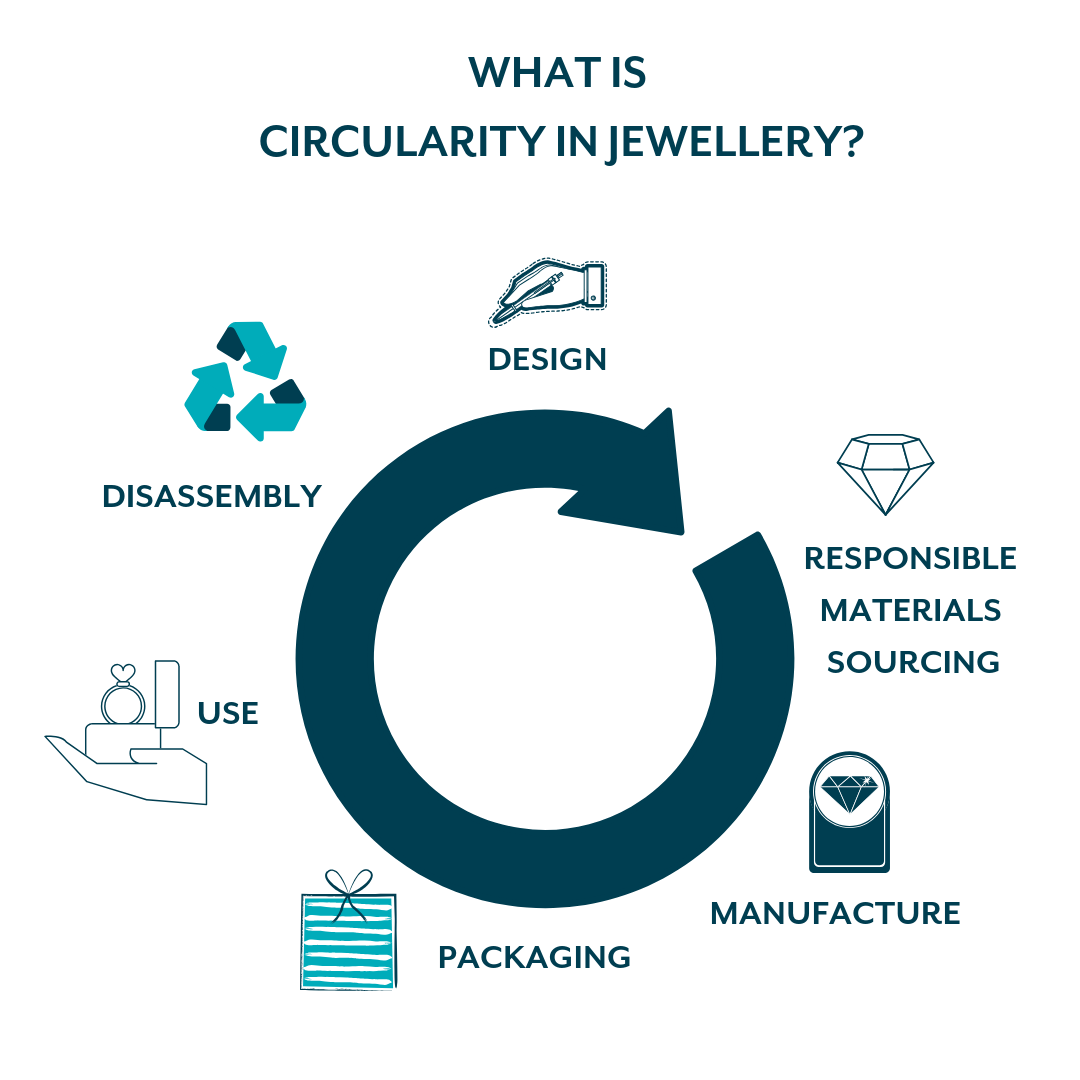Circular Economy for Sustainable Gem and Jewelry Industry
Amid the ongoing Covid-19 pandemic, which has accelerated changes in people’s everyday life - the new normal lifestyle and digital age’s quickened beginning. Moreover, all circumstances took place across the globe, for instance, climate change, use of new energy, insufficient agricultural products, pandemic, and waste and pollution problems, are linked to and affect global society and economic system. Thus, the world has focused on building a balance for sustainability.
Sustainable Development
Formerly, driving economy by responding to consumption used linear economy structure, which consumes the most resources to manufacture the highest volume of products and services. It can be simply described as make, use, and dispose. Therefore, used and unused wastes have been increasingly thrown away. Linear economy affects the world as it causes waste and pollution problems. These circumstances have led to a reconsideration of a concept in creating a balance by pushing circular economy, which focuses on using resources carefully, reducing waste generation, promoting raw material reuse, and increasing the use of clean and renewable energy to lessen impacts to society, economy, and nature. The concept has been crystalized into the 2030 Agenda for Sustainable Development during the UN General Assembly on August 25, 2015. Representatives from 193 countries affirmed the plan for countries to put into action for sustainable development in economy, society, and environment. The plan has set 17 Sustainable Development Goals (SDGs), which become the common guidelines of almost every country around the world for its national strategy.

17 SDGs: eradicating poverty (SDG1), ending hunger (SDG2), ensuring healthy lives (SDG3), ensuring quality education (SDG4), ensuring gender equality (SDG5), availability of clean water and sanitation (SDG6), clean and renewable energy (SDG7), decent work and sustainable economic growth (SDG8), industry, innovation, and infrastructure (SDG9), reducing inequality (SDG10), sustainable cities and communities (SDG11), responsible production and consumption (SDG12), combating climate change (SDG13), conservation and use of marine resources (SDG14), conserving and use of terrestrial ecosystems (SDG15), promoting peace and justice (SDG16), and partnership to achieve the goals (SDG17). Source: https://www.npc-se.co.th
Every micro and macro sector has taken the 17 goals to apply to ones’ context, for example, constructing a Green City to develop suitable environment, which emphasizes use of clean and renewable energy with proper environment for living. Copenhagen, Denmark; Amsterdam, the Netherlands; and Vancouver, Canada are the world’s Green Cities of the world in 2021 (www.neutrinobursts.com).
European Green Deal policy of the EU, which covers the goals of zero carbon emission by 2050; solving greenwashing and promoting Green Label products, which must genuinely hold “green” quality; emphasizing on using repairable materials in products to end throw-away culture; revising laws on eco-design with electronic, packaging, and plastic products; and enacting sustainable corporate governance law to control and inspect imports and manufacturers to be conform with environment and human right standards throughout supply chain.
In addition, there is an economic development model by 3 elements: B: Bio Economy is a bio-economic system, focusing on efficiently using biological resources; C: Circular Economy is reusing materials as much as possible; and G: Green Economy is a green economic system, which aims to solve pollution problems to reduce impacts to the world. Thailand holds the concept as a national agenda. It is used as a national development strategic plan for 2021-2026 to expand and create value-added from biological diversities and cultures in agricultural production, industries and local services.

Applying the Sustainable Development Goals to the Gem and Jewelry Industry
The industrial sector currently utilizes the circular economy and SDGs as part of green economic formation, with a wide range of production and services, including reductions in carbon dioxide emissions and water footprint. The model reduces losses in the product life cycle, encourages repair, restauration, renewal, reuse or even rethink, in line with the management by the manufacturing process of raw materials or waste throughout the product life cycle to reduce environmental consequences. The implementation will boost efficiency of different processes. Aside from achieving the UN’s goal of responsible production and consumption (SDG 12), the circular economy also reduces wastes from production and costs while simultaneously fostering long-term growth.

A cycle of gem and jewelry industry from https://www.levinsources.com
The circular economy has been used in the gem and jewelry business from the design stage, which is the start of the product development and production process. Traditional design usually focuses on product enchantment and consumer demand. In the end, such jewelry products are only meant to be passed down as heirlooms or pawned.. However, the key to sustainable design is reducing environmental impacts from products, such as designing with the hypothesis of minimizing conventional energy use; adhering to ecofriendly processes beginning with transparency supply acquisition by focusing on using gemstones from ethical sources; operating production processes with a focus on minimizing energy losses and wastes; and using packaging that is environmentally friendly. Recycled precious metals emitted 99% less pollution than precious metal mining. Currently, many of the world’s renowned jewelry brands have operated their business under this concept.
Sustainable design helps enabling jewelry reuse
without losses in a product life cycle.

Since Daniel Swarovski, the brand's founder, started a jewelry factory in Wattens, Austria in 1895, the world's most famous crystal jewelry firm has centered its business model on community. He valued the people around him, as well as corporate members-employees, artisans, and their families- while focusing on a business that is fair and does not harm the community or the environment. His business concept has evolved into the 4Ps, which are as follows.
People: Placing importance on human capital development by establishing Waterschool to improve awareness of environmental conservation, proper water consumption, water sanitation, and water renewal among children, young people, and their families.
Planet: Setting up a system to assess production impacts to ecosystems in order to wisely manage energy use and reduce carbon emission throughout the supply chain.
Product: Crystals and synthetic gemstones are used for Swarovski production to avoid damage to nature.
Philanthropy: Swarovski Foundation has been founded to preserve cultural heritages, promote learning, create gender equality, develop education, and protect environment.
Swarovski’s approaches are in line with the UN’s SDGs regarding gender equality (SDG5), clean water and sanitation (SDG6), proper jobs and sustainable economic growth (SDG8), responsible production and consumption (SDG12), combating climate change (SDG13), and partnership for the goals (SDG17).

The world’s major jewelry brand from Denmark, which has its manufacturing base in Thailand before exporting all over the world, has set its policy of sustainable and responsible business since its first launch in 1982. The brand’s approach includes the following 6 issues:
- Zero carbon emission by 2025 covering its factories, product distribution center, and store branches, and using renewable energy in its factories.
- Using cubic zirconia and crystal as key materials for production. Natural colored stones are selected from traceable sources with declared origin. Gold and silver must possess quality according to standards of London Bullion Market Association (LBMA).
- Increasing use of recycled gold and silver to reduce carbon dioxide emission. By 2025, PANDORA’s jewelry products will be entirely made from recycled gold and silver.
- Building harmony in the corporate without segregation. Employment, promotion, and rewarding is deliberated based on sufficient qualifications, merits, and behaviors without discrimination.
- Supporting learning and development of children and young people who are lack of opportunities by funding UNICEF’s projects in Burundi, China, Guatemala, Nepal, and Serbia.
- Prioritizing human rights to related stakeholders throughout supply chain. The issue is in line with the United Nations Guiding Principles on Business and Human Rights (UNGPs)
PANDORA’s approach is in accordance with the UN’s SDGs on ending poverty (SDG1), education quality (SDG4), gender equality (SDG5), clean and renewable energy (SDG7), responsible production and consumption (SDG12), combating climate change (SDG13), and partnership to achieve the goals (SDG17).
Furthermore, besides the global brands, Etsy, a trending online trading website focusing on handcrafted products, is another major platform selling jewelry made from recycled materials or jewelry that use the sustainability concept. There are more than ten of thousand products available under this category. Moreover, it is the first online website using the Carbon Offset for transportation of every product sold on the website. Since the Covid-19 outbreak, buyers on Etsy increased from 46.35 million to 81.9 million in 2020. Data indicates that over 60% of the buyers searched for environmental-friendly products on Etsy.

Webpages offering products on Etsy
Many countries around the world have embraced the circular economy. They have been able to generate economic value and improve life quality through the use of this economic model, which is based on a balanced coexistence with the environment. To reduce environmental impacts, the gem and jewelry industry has also implemented the model throughout its supply chain. Carrying out the model necessitates collaboration from all sectors in order to raise awareness and transform wasteful consumption into sustainable consumption, ensuring that we have enough resources for a long time. If the world’ resources run out, we may be unable to find a new planet to replace. As the former UN Secretary-General, Mr. Ban Ki-Moon once stated to raise awareness about resource consumption , “We do not have plan B because there is no Planet B”
References
2) https://pandoragroup.com/sustainability
3) https://www.swarovski.com/en-US/s-sustainability
4) https://www.statista.com/statistics/409375/etsy-active-buyers
5) The World’s 10 Greenest Cities of 2021. Retrieved July 1, 2021. From https://neutrinobursts.com
6) HOW CAN JEWELLERY BE CIRCULAR. Retrieved July 5, 2021. From https://www.levinsources.com
7) Expanding Our Sustainability Efforts. Retrieved July 15, 2021. From https://blog.etsy.com
8) เจาะยุทธศาสตร์ เพิ่มขีดความสามารถให้ 4 อุตสาหกรรมเป้าหมาย ด้วย BCG Economy. Retrieved June 20, 2021. From www.salika.co/2021/05/03/bcg-economy-in-4-targets-industrial
9) เมื่อโลกต้องการโมเดลเศรษฐกิจใหม่ ไทยจึงมี ‘BCG’ (Bio-Circular-Green Economy) เป็นวาระแห่งชาติปี 2564. Retrieve June 24, 2021. From https://www.sdgmove.com






